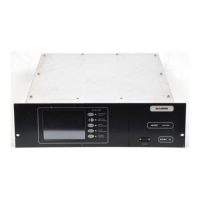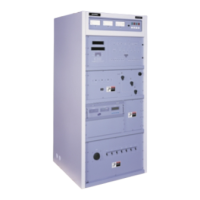Note:Allremotecontrolinputsareactivated
by applying a momentary ground connection
to each desired input. This makes the trans-
mitterdirectly compatiblewith opencollector
type remote control units as well as dry con-
tact systems. With a dry contact (relay) sys-
tem, you will simply need to momentarily
switch each of the desired control inputs to
ground in order to cause a function to occur.
The status outputs for power levels and
overloads are open collector outputs. These
are directly compatible with TTL type in-
puts, or may be used to drive small relays or
other indicating devices as long as the cur-
rent requirements are 100 ma or less.
To use a status output to drive a small
relay, you will need to connect the relay
from the status output to a DC power source
with a positive voltage between 5 volts and
24volts.AswithanyDCpoweredrelay,you
should connect a diode across the coil, with
the cathode toward the positive supply.
2.6.6. Airflow Sensor Status
In addition to the status outputs described
above, transmitters manufactured Decem-
ber 1995 and later are equipped with an
Airflow Sensor circuit which includes a
status output. A relay contact closure is
providedonTB1onthemainAirflowSen-
sor circuit board, located in the air inlet for
A20B1.
All metering samples are positive with
respect to ground and are less than 5 volts
into a 10k ohm input resistance.
2.6.7. Failsafe Connection
24VAC contactor coil current passes
through the Failsafe Interlock terminals.
Therefore, high voltage power supply acti-
vationrequiresthe presenceof acontinuous
closure across the Failsafe Interlock termi-
nals. Opening of the contacts results in de-
energizing the HV contactors.
A connection is required at the Failsafe
terminals even if the transmitter will be
locally controlled. Switching the transmit-
ter to Local control does not bypass the
Failsafe interlock.
Contacts and wiring connected to these
terminalsshouldberatedforatleast24VAC
@ 1 amp. Refer to the listing of Interface
Board connections in the Table 2-4.
The shield connection for the remote con-
trolcabling should be connectedto anearby
ground stud or one of the Interface board
mounting screws.
2.6.8. Modulation Monitor Sample
An adjustable, 1 to 5 Volt RMS signal
source is provided on the Output Monitor
board. The Output Monitor board is located
behind an access door on the front. Route
the cable for the modulation monitor from
the base of the transmitterup to the location
of the Output Monitor board. The coax will
slip into the gap between the transmitter
walland the enclosure for the Output Moni-
tor, RF Oscillator, and PDM Generator.
Connect modulation monitor to the BNC
jackontheOutputMonitorboardA18.Besure
topositionthecoaxsafelyawayfromany
components which may generate enough heat
to melt the insulation on the coaxial cable.
2.7. Initial Turn On Procedure
Before initial turn on, ensure that the fol-
lowing items are checked:
a. Ground strap is properly connected be-
tween transmitter and station earth
ground.
b. Check for debris/hardware in base of
transmitter and in AC Panel.
c. Make sure all hardware connections are
tight.
d. AC input wiring is properly connected.
e. Transmitter output is properly termi-
nated into a suitable load capable of
handling rated output power (antenna or
dummy load).
f. Audio input is properly connected.
g. Monitoring equipment is properly con-
nected.
h. The REMOTE/LOCAL switch on the
Controller board (on the swing out
panel) should be in the local mode.
i. Be sure the front and rear covers are in
place.
2.7.1. Initial Turn On
Important
Temporarily remove F1 from the Interface
board. This will disable the contactor circuit
for the first part of the turn-on procedure.
Fasten the bottom front panel in place with at
least two screws.
WARNING
THE NORMAL PROCEDURE FOR
TRANSMITTER TURN OFF SHOULD BE
FOLLOWEDINORDERTOPROPERLY
DISCHARGE THE HIGH VOLTAGE COM-
PONENTS. TURN OFF THE HIGH VOLT-
AGEBYDEPRESSINGTHEOFFBUTTON.
IFYOUMUSTENTERTHETRANSMITTER,
SET THE REMOTE/LOCAL SWITCH TO
LOCAL AND ALLOW THE POWER SUP-
PLY TO DISCHARGE AS INDICATED BY
THE FRONT PANEL METERS.LOW VOLT-
AGE MAY THEN BE REMOVED BY SET-
TING THE LOW VOLTAGE CIRCUIT
BREAKER TO OFF. DISCONNECT ALL
PRIMARY POWER SERVICE. REMOVE
THE REAR LIFT OFF PANEL SLOWLY TO
ALLOW THE RESISTOR DISCHARGE
MECHANISM TO FUNCTION.A GROUND-
ING STICK IS PROVIDED IN THE TRANS-
MITTER AND SHOULD BE USED TO AS-
SURE THAT ALL HIGH VOLTAGE HAS
BEEN REMOVED UNDER FAULT CONDI-
TIONS. BE CAREFUL NOT TO GROUND
ANY CONNECTIONS WHICH ARE STILL
ENERGIZED.THIS WOULD INCLUDEALL
LOW VOLTAGE CIRCUITS IF THE LOW
VOLTAGE CIRCUIT BREAKER HAS NOT
BEEN SET TO OFF POSITION.
CAUTION
IF ANY ABNORMALITIES ARE ENCOUN-
TERED IN THE FOLLOWING STEPS, STOP
THE PROCEDURE, REMOVE ALL POWER,
AND PROCEED TO TROUBLESHOOTING
SECTION OF MANUAL.
a. Using a small blade screwdriver or ad-
justing tool, rotate the LOW power level
control pot (located below the LOW
powerON switch) severalturns counter-
clockwise. The other pots may be left at
the factory settings for now.
b. Apply AC power to transmitter.
c. Set the LOW VOLTAGE circuit breaker
A20CB1 to ON position.
d. Verify the +/- 12 volt supply LED’sillu-
minate on the control panel.
e. Ifyou havea3 phaseGATESFIVE,verify
red LED on Phase Monitor (in the contac-
tordrawer)isilluminated.IftheLEDisnot
illuminated, either the Phase Monitor is
not adjusted for the correct line voltage or
thephase sequence is backwards.Remove
all power and adjust the voltage selector
on the Phase Monitor to the lowest setting
and re-apply power.
f. If the LED is still not illuminated, re-
move all power and reverse any two
leads in the main disconnect box and
re-apply power and verify that the LED
is illuminated. Adjust the voltage selec-
tor so that the red LED on the Phase
Monitor relay illuminates when AC
power is applied. In this adjustment, al-
low for a reasonable sag in line voltage,
but do not desensitize it so far that it will
be ineffective.
Note: The Phase Monitor relay adjust-
ment is affected only by the particular line
voltage. Itis not affected by thechanging of
transformer taps which may be done later.
g. Install screws holding AC Power panel
in place.
WARNING
ENSURE ALL VOLTAGE IS REMOVED
FROM TRANSMITTER AND ALL POINTS
WHERE VOLTAGE HAS BEEN APPLIED
ARE GROUNDED BEFORE CHANGING
ANY TAPS IN THE FOLLOWING STEP.
h. Use a suitable voltmeter to measure the
+/-20voltsupply.A convenientpointfor
checking these voltages is on the PDM
Rev. AC: 2/29/00 888-2314-001 2-5
WARNING: Disconnect primary power prior to servicing.
